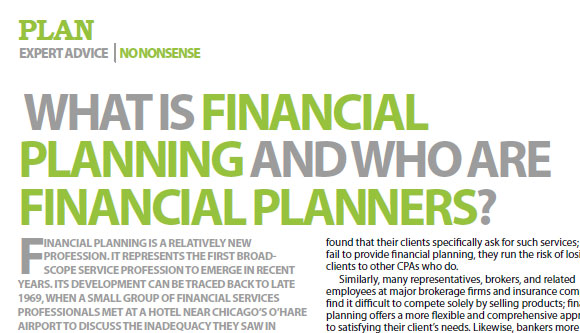Financial Planning Helps Prevent Osteoporosis
EXPERT ADVICE>FINANCIAL PLANNER
By Henry Ong, RFP®
Financial Planning Helps Prevent Osteoporosis
As kids, we were taught by our parents to have good posture. While the immediate reason given is so that our friends would not laugh at us for having hunched backs, one of the real reasons is so that we would not have bone problems as in osteoporosis.
Osteoporosis is a disease that makes the bone prone to fractures. The key measures for preventing osteoporosis are a good diet, exercise and good posture. And believe it or not, sound financial planning helps promote good posture.
A heavy debt burden, inadequate savings, and low capacity for discretionary spending are but some of the financial problems that affect many. Such problems lead to incessant worrying about the future, a lack of self confidence and sometimes even desperation. With such a heavy load, who would not end up walking with drooped shoulders, sitting in a slouched position, and constantly tossing and turning in bed? All of these lead to bad posture.
Now imagine the opposite. A person’s debt is manageable if it’s non-existent. His savings are enough to tide his family over for at least half a year in case of a loss of job or a significant loss in the family business. There is more than enough savings to enjoy three square meals a day and then some. Walking through the mall on weekends, which is the national pastime, does not lead to excessive salivating because of the thought that there is capacity to spend. Yet because of the instilled discipline, there is restraint in spending, especially on the non-essentials. A person in this kind of financial situation would walk tall, chin up high, with a giant smile on his face. And not only him; his whole family would also feel the confidence as they go through life with minimal money worries.
Are these all textbook theories? Not at all! Countless families have gone through this amazing transformation from walking with their heads down low to being a shining beacon of financial freedom. If you want proof, just sit in one corridor of a mall and observe people as they pass by. With your focus sharpened, you would begin to see who is financially free and who is not just by their posture. Why, you could even observe your co-workers. Body language speaks volumes. You would be surprised that even those who don’t appear to be well off will be happy and financially free just by looking at their posture.
This brings me to another point. Notice that what I cited as the cause for bad posture are a heavy debt burden, inadequate savings, and low capacity for discretionary spending. I didn’t mention inadequate income as the cause. Most of the time, it never is. I have done a talk for janitors of a school and to my excitement, I found one of them as an example of how income is not an issue.
One of the janitors had a house, a car, and children sent to college. This is all because he followed the financial planning equation of “INCOME minus SAVINGS equals EXPENSES.” Savings always came ahead of spending. It was this philosophy that carried him and his family through, in good times and in bad, even with a modest income. As the saying goes, “It’s not what you got but how you use it.”
One last thing, savings is a great start. Sometimes, though, simply saving may not be enough. This is the time when we have to boost our savings by investing them. Investing is quite complicated and ALWAYS involves risks. But done properly, investing can help achieve our financial goals easier and faster. Now how would you go about investing properly?
The first step is to determine what your goals are. Do not just dive into investing especially if you are not familiar with it. Many say that investing in the stock market is gambling. I agree, if you get into it without adequate preparation.
Next would be to see what returns you will need to get to reach your goals but always tempered by the investment risks (e.g. loss of income and even principal) that you are willing to take. We are a nation of “time deposit-minded” investors. What I mean by this is that we are so used to getting a guaranteed fixed return over a fixed period. In normal times, such would only bring low income, which would sometimes not even be enough to cover inflation. On the other hand, once approached with an offer of stellar returns, we jump at it without consideration for the risk involved. Higher returns invariably mean higher risks.
The third step is to look at what is out there. There are lots of investment options available to Filipinos. You just have to ask around. And mind you, investing can range from financial securities to businesses to real estate and even to art and jewelries.
The fourth step is to form a portfolio of investments. What this means is that you should not put all of your money in one investment outlet. If that goes belly up, so does all of your funds. Diversification is the key.
Lastly, you need to periodically review your performance relative to your targets and risk parameters. How often? Perhaps, initially, every month. Then, as you grow accustomed to investing, every quarter.
Now, if you find the five steps above pretty daunting, the simple solution is to get a financial planner. As I have mentioned in previous articles, there are Registered Financial Planners (RFPs) out there who are experts in this area. They are specifically trained to assist their clients in handling their finances. For more on RFPs, log on to www.rfp-philippines.com.
Here’s to your good posture!
[PULL QUOTE]
“Body language speaks volumes. You would be surprised that even those who don’t appear to be well off will be happy and financially free just by looking at their posture.”
[PROFILE]
Henry Ong, RFP is the founder of the Philippine chapter of the Registered Financial Planner Institute of USA. He is also the President of the Association of Registered Financial Planners of the Philippines (ARFPP), the premiere professional body of practicing financial planners in the country. For more information about RFP Philippines, visit www.rfp-philippines.com.



